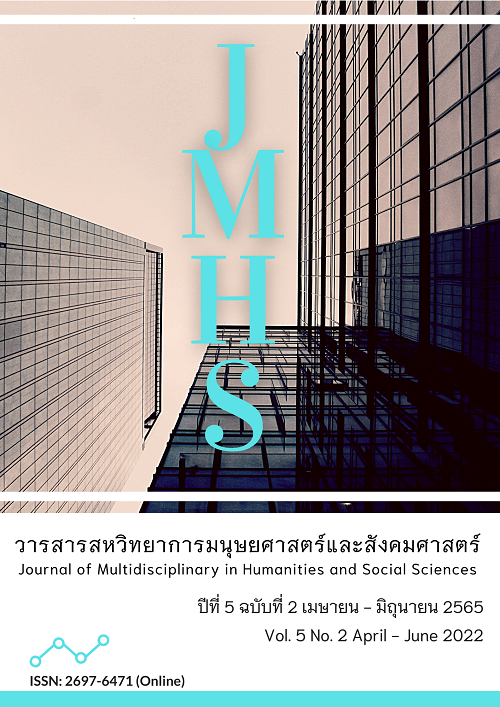A Study of The Buddhist Insight Meditation Practice in Sāla Sutta
Main Article Content
Abstract
The objectives of this article were 1) to study the content and important teachings in Sāla Sutta, and 2) to study Vipassana practice in Sāla Sutta. The research data was taken from Theravada Buddhist scriptures and documents related, then summarized, analyzed, and finally compiled in descriptive type. The results revealed that the description of vipassana practice in Sāla Sutta revealed that the practical method refers to Vipassana meditation based on Mahāsatipaṭṭhāna principles, namely 1) in Kāyānupassanāsatipaṭṭhāna, the practitioners must start, with diligence and continual awareness, observing four movements of the body, namely walking, standing, sitting, and lying down, etc.; 2) in Vedanāunpassanāsatipaṭṭhāna, the practitioners, with diligence and continual awareness, observes feeling namely happiness, suffering, and equanimity; 3) in Cittānupassanāsatipaṭṭhāna, the practitioners, with diligence and continual awareness observing the 16 consciousness types, for example, having mental lust, he knows that the mind has lust, etc.; and 4) In Dhammānupassanāsatipaṭṭhāna, practitioners, with diligence and continual awareness, observe all mental formations in 5 sections, for example, the Yogi uses mindfulness to observe the five hindrances, which are the barrier of attaining wholesome mind such as absorption etc. They are other important teaching in this Sutta: 1) Ātāpī or great diligence for eliminating defilements, and 2) the four types of awareness or Sampajañña, namely Sātathakasampajañña, Sāppāyasampajañña, Gocarasampajañña, Asammohasampajañña.
Article Details

This work is licensed under a Creative Commons Attribution-NonCommercial-NoDerivatives 4.0 International License.
Views and opinions appearing in the Journal it is the responsibility of the author of the article, and does not constitute the view and responsibility of the editorial team.
References
ชัยชาญ ศรีหานู. (2564). วิเคราะห์คำสอนวิปัสสนาในเตภูมิกถาที่มีผลต่อคตินิยมเชิงพุทธในสังคมไทย. วารสาร มจร บาฬีศึกษาพุทธโฆสปริทรรศน์, 7(1), 12-26.
พระธรรมกิตติวงศ์ (ทองดี สุรเตโช). (2554). พจนานุกรม เพื่อการศึกษาพุทธศาสน์ คำวัด. กรุงเทพฯ: ธรรมสภาและสถาบันบันลือธรรม.
พระพรหมคุณาภรณ์ (ป.อ.ปยุตฺโต). (2554). พจนานุกรมพุทธศาสน์ ฉบับประมวลศัพท์. (พิมพ์ครั้งที่ 16). กรุงเทพฯ: สำนักพิมพ์ผลิธัมม์.
พระพรหมคุณาภรณ์ (ป.อ.ปยุตฺโต). (2556). พจนานุกรมพุทธศาสตร์ ฉบับประมวลธรรม. (พิมพ์ครั้งที่ 25). กรุงเทพฯ: สำนักพิมพ์ผลิธัมม์.
พระพุทธโฆสเถระ. (2554). คัมภีร์วิสุทธิมรรค. (สมเด็จพระพุฒาจารย์ (อาจ อาสภมหาเถร), แปล). (พิมพ์ครั้งที่ 10). กรุงเทพฯ: ธนาเพรส.
พระมหากิตติณัฏฐ์ สุกิตฺติเมธี. (2564). การวิเคราะห์แนวทางงดเว้นจากความเสื่อมในปราภวสูตร. วารสารสหวิทยาการมนุษยศาสตร์และสังคมศาสตร์, 4(1), 84-95.
พระสมชาย บัวแก้ว, พระมหาบุญศรี วงค์แก้ว และ สุเชาวน์ พลอยชุม. (2564). อภิสมาจาร: กระบวนการพัฒนาบุคลิกภาพตามแนวพระพุทธศาสนา. วารสารศิลปการจัดการ, 5(3), 895-907.
มหาวิทยาลัยมหาจุฬาลงกรณราชวิทยาลัย. (2539). พระไตรปิฎกภาษาไทย ฉบับมหาจุฬาลงกรณราชวิทยาลัย. พระนครศรีอยุธยา: มหาวิทยาลัยมหาจุฬาลงกรณราชวิทยาลัย.
Damnoen, P. S., Chaiworamankul, Y., Thammawatsiri, P. A., & Soontrondhammanitus, P. (2021). Buddhist Ethics and the way of Living in Daily Life: An Analysis of Genital Malfeasances (Kāmesumicchācāra). Turkish Journal of Computer and Mathematics Education, 12(8), 2943-2948.
Tan, C. C., & Damnoen, P. S. (2020). Buddhist Noble Eightfold Path Approach in the Study of Consumer and Organizational Behaviors. Journal of MCU Peace Studies, 8(1), 1–20.
Yusamran, P. P., Thitipasitthikorn, P. P., Damnoen, P. S., Thienthong, P. B., Rattana-ngam, S., & Homchan, P. (2021). Conservative and inheritance of Atthami Bucha day for sustainable promotion tourism. Journal of Positive Psychology and Wellbeing, 5(3), 1400–1410.


